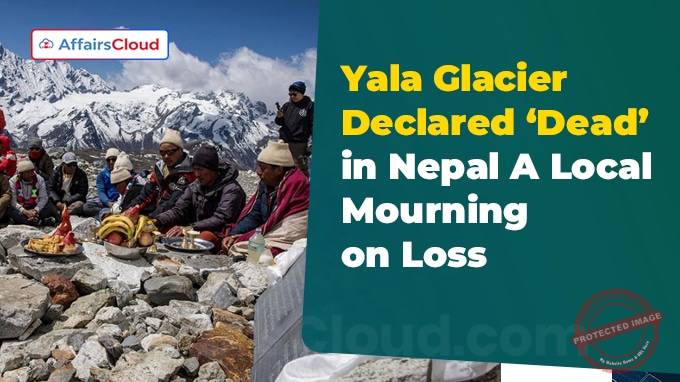 In May 2025, the Yala Glacier in Langtang Valley, Nepal, was declared “dead” during Asia’s first glacier funeral, after losing 66% of its ice and retreating 784 meters(m) since the 1970s, highlighting the severe impact of climate change in the Hindu Kush Himalayan (HKH) region.
In May 2025, the Yala Glacier in Langtang Valley, Nepal, was declared “dead” during Asia’s first glacier funeral, after losing 66% of its ice and retreating 784 meters(m) since the 1970s, highlighting the severe impact of climate change in the Hindu Kush Himalayan (HKH) region.
- The event, coordinated by the Kathmandu (Nepal)-based International Centre for Integrated Mountain Development (ICIMOD), witnessed the participation of over 50 glaciologists, Buddhist monks, and local community members from Nepal, India, China, and Bhutan.
Note: The HKH region extends across twelve countries: Afghanistan, Bangladesh, Bhutan, China, India, Kyrgyzstan, Mongolia, Myanmar, Nepal, Pakistan, Tajikistan, and Uzbekistan.
Key Details of the Event:
i.Memorial Plaques: Installed at the glacier’s base, featuring messages in English, Nepali, and Tibetan by authors Manjushree Thapa and Andri Snaer Magnason.
- The plaques emphasize the loss of 54,000 HKH glaciers, most projected to vanish by 2100 due to 426 ppm (part per million) Carbon dioxide (CO₂) levels in May 2025.
ii.Global Precedents: Yala is the third glacier worldwide and the first in Asia, to receive such a memorial, following Iceland’s Okjökull (Ok glacier) (2019) and Mexico’s Ayoloco (2021).
iii.Scientific Significance: Yala was among 7 glaciers in the HKH monitored annually for over a decade. It provided critical data on ice loss impacting 2 billion people dependent on HKH rivers.
- It is one of 38 glaciers monitored through in-situ measurements, offering vital data on the rate and scale of glacial retreat.
- Since 1975, Earth’s mountain glaciers have lost an estimated 9 trillion tonnes of ice, equivalent to a 2.72-metre (m) thick ice block covering the size of India.
iv.Snow persistence in the Ganga basin has dropped to 24.1% below normal, the lowest in 23 years, posing threats to water security and biodiversity.
Global and National Conservation Efforts:
i.The United Nations (UN) has designated 2025 as the International Year of Glaciers’ Preservation. March 21 is to be annually observed as the World Day for Glaciers.
ii.Global Initiatives include:
- UNESCO’s Intergovernmental Hydrological Programme.
- International Union for Conservation of Nature (IUCN)’s Himalayan Adaptation Network.
- World Wide Fund for Nature (WWF)’s Living Himalayas Initiative.
iii.India’s initiatives include:
- National Mission for Sustaining the Himalayan Ecosystem (NMSHE)
- Network Programme on the Himalayan Cryosphere
- Monitoring by the Indian National Centre for Ocean Information Services (INCOIS).
- Research through Himansh Station and polar expeditions like India’s Arctic Observatory (IndARC) (2014).
About Nepal:
Prime Minister(PM) – Khadga Prasad Sharma Oli
President – Ram Chandra Poudel
Capital – Kathmandu
Currency – Nepalese Rupee (NPR)




